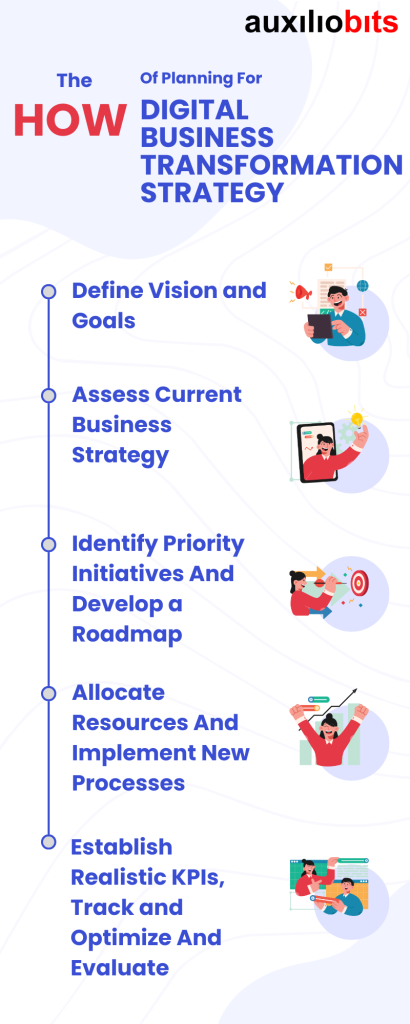
Key Takeaways
- Business, as we know, is changing, and embracing technological advancements is the way to grow and flourish.
- Digital transformation offers several benefits including enhanced operational efficiency, improved customer experience, provides a competitive edge to the business, and more.
- Digital transformation begins with a well-crafted strategy. A digital business strategy serves as a guiding blueprint for digital business transformation.
- Digital transformation is not a one-time project but an ongoing journey that demands careful planning and execution.
In today’s fast-paced and dynamic business landscape, digital transformation transcends being a mere trend; it is a critical necessity. Business, as we know, is changing, and embracing technological advancements is the way to grow and flourish. In fact, 87% of business leaders are firm believers in digitalization being a company priority. [Source: Gartner]
Digital business transformation is changing how an organization operates by leveraging digital technologies skillfully. It goes beyond adopting individual technologies and involves a holistic, organization-wide shift towards a digital-first mindset. It is not a one-time project but an ongoing journey aimed at sustained success for the organization in the digital era.
This comprehensive guide will provide a clear roadmap to navigate a successful digital business transformation by the end. Before that, let’s explore the key benefits of the transformative journey:
Key Benefits of Digital Transformation
- Enhanced Operational Efficiency
The RPA (Robotic Process Automation) technology is deployed to automate rule-based tasks. Automation of routine tasks not only helps organizations save time on repetitive tasks but also reduces the likelihood of errors, increasing overall efficiency. As a matter of fact, around 69% of IT decision-makers view digital transformation primarily as a means to improve process efficiency. [Source: Baker McKenzie]
Moreover, leveraging data analytics enables the streamlining of processes and analysis of data trends and patterns that facilitate prompt responses to market changes. Innovating new products and services to stay ahead of the competition is attainable due to the rapid adaptation to market trends, customer demands, and emerging technologies.
- Improved Customer Experiences
Another key advantage of digital transformation is improved customer experience. AI (Artificial Intelligence) makes it easier to gather instant customer feedback, allowing for quick refinements to products, services, or processes. Utilizing customer insights allows for personalization, enabling organizations to tailor interactions based on individual preferences.
Additionally, the adoption of diverse digital channels facilitates seamless customer experience across various touchpoints, offline or online. It also enhances accessibility, responsiveness, and overall satisfaction for customers. Leveraging customer analytics even boosts revenue growth about twice as much for organizations that don’t, as per McKinsey. [Source: McKinsey]
- Innovation and Competitive Edge
Approximately 64% of organizations feel the need to transform their digital businesses to stay competitive in 2024 and beyond [Source: McKinsey]. Digital transformation opens avenues for the development of new products, services, or business models. Embracing innovation and a customer-centric approach not only paves the way for global expansion but also solidifies a competitive advantage in diverse industries.
Digital tools also contribute to resource optimization, resulting in significant cost savings. Cloud computing, a key component of digital transformation, reduces infrastructure costs, increases scalability, and facilitates remote collaboration. All of which contribute to overall cost-effectiveness and gaining the upper hand.
- Improved Employee Productivity and Collaboration
A majority of organizations perceive digital transformation to greatly impact workplace transformation, which results in higher productivity and improved customer experience. Digitalization makes remote work smoother with the help of collaboration tools, enhancing employee flexibility and productivity. This, in turn, promotes a healthier work-life balance and continuous skill development, fostering a culture of learning and a collaborative work environment.
- Enhanced Security Measures
Addressing security concerns as an integral part of the strategy can create a more resilient and secure digital infrastructure. Adopting robust cybersecurity measures and implementing cutting-edge solutions such as next-generation firewalls, intrusion detection systems, and identity and access management (IAM) ensures the security of sensitive data in an increasingly digital environment.
Automation of compliance processes becomes more manageable, ensuring that organizations adhere to industry regulations and standards.
Digital transformation begins with a well-crafted strategy. A digital business strategy serves as a guiding blueprint for digital business transformation. It provides a decision-making framework, helps to navigate the complexities of the dynamic business ecosystem, and ensures alignment with business goals.
How To Plan a Digital Business Transformation?

- Define Vision and Goals
A clear vision and well-defined mission are the basis for any successful transformation. It is a foundational step in articulating a compelling vision for the future and establishing specific goals to achieve that vision.
Begin with identifying the need for the transformation process. What is the purpose, and what specific outcomes do you aim to achieve? Are you looking to enhance customer experiences, improve operational efficiency, or enter new markets? You are essentially looking for the answers to the questions ‘What do we want?’ and ‘How do we get it ?’.
A crystal-clear vision outlines your aspirations for the future and sets the direction for the entire transformation. The next step is to establish specific and quantifiable goals. It ensures that objectives are unambiguous, practical, and aligned with the broader business strategy.
- Assess Current Business Strategy
Before charting a course for the future, it is essential to understand your current position. Conduct assessments of existing business strategies, processes, and technologies. Identify and evaluate your strengths, weaknesses, opportunities, and threats. A SWOT analysis is a valuable tool in this phase. Leverage your internal strengths, address the weak points and opportunities for improvement, and potential threats, including market trends and competition.
Explore new projects, processes, technologies, and ways to enhance them with digitalization. This assessment serves as a baseline, guiding the development of strategies tailored to your organization.
- Identify Priority Initiatives
With a clear vision and a holistic understanding of your current state, the next step is to pinpoint key transformation initiatives. It is a crucial step for organizations to streamline their digital transformation efforts. It ensures a focused and efficient approach to achieving objectives.
Prioritization helps allocate resources effectively and also aids in focusing energy and resources on a fixed set of objectives at any given time. Using data insights, involving stakeholders, focusing on customer needs, analyzing risks, and identifying quick-win projects with continuous review, adjustment, and communication can help identify priority projects.
However, not all changes can or should happen simultaneously. So, consider factors like feasibility, impact on business objectives, and alignment with the goals before moving forward with your priority initiatives.
- Develop a Roadmap
A well-thought-out business strategy is like having a trusty roadmap. It ensures everyone is on the same page and working towards shared goals. It outlines timelines, milestones, and dependencies between different initiatives.
A digital transformation roadmap acts as a guide for navigating the ever-changing business landscape and its complexities. Flexibility in a roadmap enables the organization to adapt to unforeseen challenges without deviating from the ultimate vision.
The development of a roadmap necessitates collaboration between key stakeholders to ensure alignment with the business objectives and expectations. Transparent and effective communication fosters trust mitigates resistance, and aligns everyone toward a common goal.
- Allocate Resources
Allocation of resources is a critical step that can make or break your digital transformation. It requires a thoughtful balance between short-term investments and long-term gains. Digital transformation requires the allocation of resources in terms of budget, personnel, and technology.
Establish a dedicated budget for the transformation, taking into account potential expenses related to technology adoption, training programs, and changing management efforts. Keep in mind the requisite skill sets demanded by emerging technologies and evolving processes before allocating personnel. Invest in training and skill development programs to empower your workforce to adapt to the changes effectively.
- Implement New Processes
After resource allocation, it is time to put your plans into action. Implementation of new processes and technologies can be challenging and even more so when met with resistance from within the organization. Rolling out new processes involves more than just adopting cutting-edge technologies. It requires a cultural shift within the organization. Effective management is the key to securing the potential benefits of transformation.
A McKinsey & Company report states that 70% of digital transformation initiatives fail because of employee resistance. [Source: McKinsey ]
Communicating the benefits of the changes to the employees, providing adequate training, and creating channels for ongoing support can help mitigate resistance. In addition, it will foster collaboration and communication and empower the workforce to embrace the new working approach.
Keep a close eye on key performance indicators (KPIs) every so often to measure the impact of the changes. Early feedback and monitoring allow for quick adjustments.
- Establish Realistic KPIs
Key Performance Indicators (KPIs) are like signposts, guiding you toward the right path. They play a crucial role in measuring the success of your digital transformation initiatives. Whether improving customer satisfaction, increasing operational efficiency, or boosting revenue, your KPIs should provide a clear picture of progress.
Make your KPIs SMART – Specific, Measurable, Achievable, Relevant, and Time-bound. It is not just about tracking but also about using that information to make informed decisions.
Regular assessments of KPIs ensure they remain in line with the evolving needs of the organization. Timely adjustments may be necessary to gain insights and experience the impact of the transformation on your business.
- Track and Optimize
Now that the plan is in motion, its continuous monitoring is crucial to stay vigilant. Monitoring goes beyond quantitative metrics. Regularly tracking performance using established KPIs and actively seeking qualitative feedback from employees, customers, and other stakeholders provides a holistic view of the transformation and identifies areas for improvement.
This multi-dimensional process ensures that your organization remains agile and responsive to changes in the business environment. Optimization is not just about fixing what is wrong; it is about fine-tuning your approach to extract maximum value. Embracing a culture of continuous improvement encourages employees at all levels to contribute ideas for development.
- Evaluate
The journey doesn’t end here; as the transformation progresses, evaluate the overall effectiveness of the initiatives. It involves taking a step back and assessing the results and value addition to the organization.
Conduct periodic assessments, review KPIs, gather feedback, and analyze the overall performance against predefined benchmarks to gauge the impact of the implemented changes. Use the insights to make informed decisions and refine your strategies and processes. Learn from challenges instead of viewing them as setbacks and address them proactively. Use the experience to enhance your future initiatives.
Conclusion
In conclusion, embarking on a successful digital business transformation is imperative in today’s world. Recognize that this transformation is not a one-time project but an ongoing journey that demands careful planning and execution.
The benefits are plentiful and significant – increased operational efficiency, better customer experience, cost savings, and many more. By embracing principles and committing to ongoing improvement, organizations can navigate the dynamic business landscape seamlessly and move onward and upwards.
Make your digital transformation journey seamless with Auxiliobits! Our experts have in-depth knowledge of digital technologies and domain experience to recommend and deploy customized digital transformation solutions for your business.








